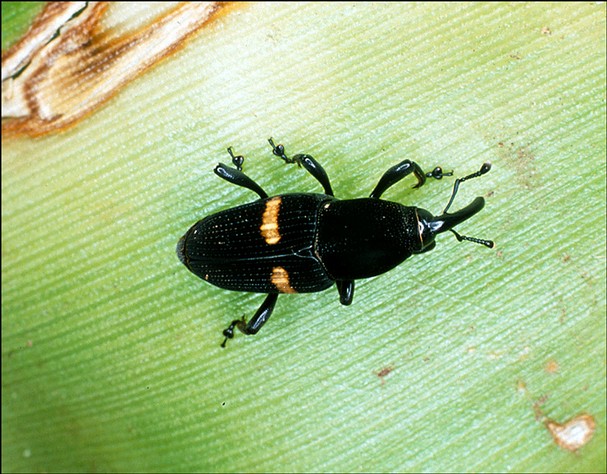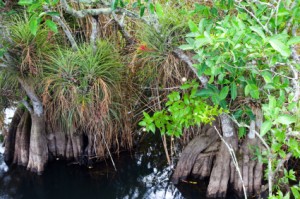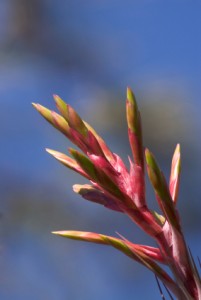The Mexican Bromeliad Weevil
Author: Melanie Dearringer2 Comments
An invasive exotic species is a plant, animal or insect that was introduced to an environment through unnatural means. These species very often cause massive destruction to the native ecosystems. Because they did not originate within the local ecosystem, they do not have natural predators, disease or competition. Exotic species, introduced into the wild, usually reproduce unchecked and often killing local populations of plants, animals or insects. The balance of life in various ecosystems is very important to the health of all species and is very fragile. That is why it is so important to guard against the introduction of exotic species that may be invasive and eradicate those invasive species already actively causing destruction. One such species that is particularly detrimental to bromeliads in Florida, is the Mexican Bromeliad Weevil.
Metamasius callizona
The Mexican Bromeliad Weevil, scientifically known as Metamasius callizona, and also called the “Evil Weevil” by many bromeliad lovers located in Florida, is an invasive exotic species. The “Evil Weevil” is ravishing Florida’s natural bromeliad population. The Mexican Bromeliad Weevil was introduced into Florida in 1989 on a shipment of Tillandsias travelling from Mexico to a nursery in Broward county.
Despite immediate measures taken to eradicate the weevil from the nursery, the weevil still infested Broward county bromeliads and has continued to stretch outward and today reaches into the Everglades. The weevil’s original, natural range was previously confined to Mexico.
Appearance and Life Cycle

-The Mexican Bromeliad Weevil
The adult Mexican Bromeliad Weevil can be distinguished from other Florida native bromeliad weevils by its dark body and one yellow or orange horizontal band across the wing covers. It is between 11 and 16 mm long. The weevil moves from egg stage to larvae then pupae and finally adult in the span of 8-10 weeks. Adult females both feed on and lay eggs inside the stems and leaves of bromeliads and sometimes consume the flowers as well. The larvae then mine through the plant feeding on the stem tissue. The pupae build a cocoon from the plant material at the base of the plant. While the adult can cause significant damage to the leaves and flowers of the bromeliad it is the larvae that typically lead to the plant’s destruction. It is suspected that breeding continues year round and there can be three to four generations of weevil in one year.
Damage
Plants under attack will show damage on their leaves from adult feeding. The leaves will also begin to brown and wilt. The larval mines will be evident and some bromeliads will produce a brown gelatinous substance that covers the holes where eggs were laid. The weevil most frequently attacks epiphytic bromeliads. Most air plants will become limp and even lose the support of their root attachments to their host causing them to drop from the canopy. In natural areas where bromeliads are being attacked by the “evil weevil” the ground will often be littered with fallen air plants.
Threatened and Endangered Plants

Group of Bromeliads in Florida Swamps
The “evil weevil” is of particular concern because it is attacking some of Florida’s rarest air plants and endangering formerly common place bromeliads. The list of now endangered or threatened bromeliads that are under attack by the “evil weevil”, as presented by the University of Florida Entomology Department, includes: Tillandsia utriculata Linnaeus Giant airplant, Tillandsia balbisiana Schultes Northern needleleaf, Tillandsia flexuosa Swartz Twisted airplant, Tillandsia fasciculata Swartz Cardinal airplant – Yellow bract, Tillandsia fasciculata Swartz Cardinal airplant – Red bract, Tillandsia variabilis Schlechtendal Leatherleaf airplant.
Currently, the weevil attacks primarily the Tillandsia genus, but it is suspected that some Guzmania and Catopsis could also be susceptible to the Mexican Bromeliad Weevil. It typically attacks epiphytic plants that have enough stem and leaf tissue to support larval growth. Small, narrow leaved Tillandsia such as Spanish Moss are not suspected to be in danger of a weevil attack. However, it is suspected that if the populations of more desirable bromeliads are entirely decimated the weevil could survive on even these unlikely species of bromeliads.
Chemical Control
Bromeliad enthusiasts are pursuing several methods to control the spread of the Mexican Bromeliad Weevil. Chemical control is possible in nurseries and private collections. It requires frequent spraying or dipping of plants, but can be managed. Natural habitats pose a particular problem because most of the plants under attack are located high in canopies, out of reach. The University of Florida also sites the problem of these plants being in public places and ecosystems where the effect of chemical management on other species is unknown. It is important that careful research is conducted so that any management process does not cause more harm than good. There are also biological control options being considered.
Biological Control

Pink Bromeliad in Florida
In the wild, biological control may be an appropriate alternative to chemical control. Biological control would include finding natural predators of the Metamasius callizona and introducing them into areas where they are attacking bromeliads. Two species of fly are currently being studied to see if they will be able to control the weevil in Florida eco-systems. According the University of Florida, the Lixadmontia franki, a tachinid fly, was found in the early 1990’s in Honduras as a parasite on a different variety of bromeliad weevil. The fly larvae develops in the weevil larvae using it as a host. In the laboratory the fly was observed using a Mexican Bromeliad Weevil larvae as a host. In 2007, after extensive study in the laboratory permission was granted release the fly into several areas of know weevil infestation. Its effectiveness is still being monitored.
Saving Seeds
In the meantime, while control methods are being studied, individuals and bromeliad societies are taking action to preserve the genetic diversity found in the endangered bromeliads, so that Florida’s native bromeliads are not lost forever. The Florida Council of Bromeliad Societies has started an extensive seed collection project. Seeds have been gathered from various threatened bromeliads and nurseries have volunteered to germinate the seeds keeping the production of the rare bromeliads continuing and carefully managed. Once the “Evil Weevil” is under control the bromeliads can be reintroduced into the devastated areas. This will prevent the loss of significant bromeliad species. The Florida Council of Bromeliad Societies is also conducting extensive public educational outreach. The more informed individuals are about the pressing issues surrounding the destruction of native Florida bromeliads, the faster the public can work together to find a solution.
Saving Ecosystems
Ecosystems are incredibly fragile and it is difficult to know what the eradication of one or more species will do to its delicate balance. Bromeliads support many other insects and animal species and their interaction in specific areas may be key to maintaining a healthy environment for all species. This is what makes addressing the weevil problem so crucial for everyone, not just bromeliad growers and enthusiasts. With continued research and public support the Mexican Bromeliad Weevil may be controlled and rare bromeliad species throughout Florida can be saved.
Sources
“Biological Control of the Mexican Bromeliad Weevil.” Save Florida’s Native Bromeliads. <http://fcbs.org>
Frank, JH. “Florida Native Bromeliads Illustrated.” <http://entnemdept.ufl.edu/frank/bromeliadbiota/flbrom.htm>
Larson, Barbra, and Frank, Howard. “Featured Creatures.” University of Florida Institute of Food and Agricultural Sciences, Department of Entomology and Nematology. <http://entnemdept.ufl.edu/creatures/orn/m_callizona.htm>
“Lixophaga sp. Potential Biolofical Control Agent of the Mexican Bromeliad Weevil.” Save Florida’s Native Bromeliads. <http://entomology.ifas.ufl.edu/frank/savebromeliads/Admontia.htm>
The Mexican Bromeliad Weevil photo credit: Naple News viahttp://www.naplesnews.com/photos/2007/jun/24/38103/
2 Responses to “The Mexican Bromeliad Weevil”
Leave a Reply

Resource Download
Hechtia Care Cheat Sheet
Learn how to care for your Hechtia bromeliad with this quick and easy informational guide.
Learn More
Ask an Expert
Questions about bromeliads?
Our experts love a challenge!
Photo of the Week
Submit your photo to be featured on the blog!
More Photo of the Week Winners
Submit Photo








Great information!
I’m always on the look out for this little pest!